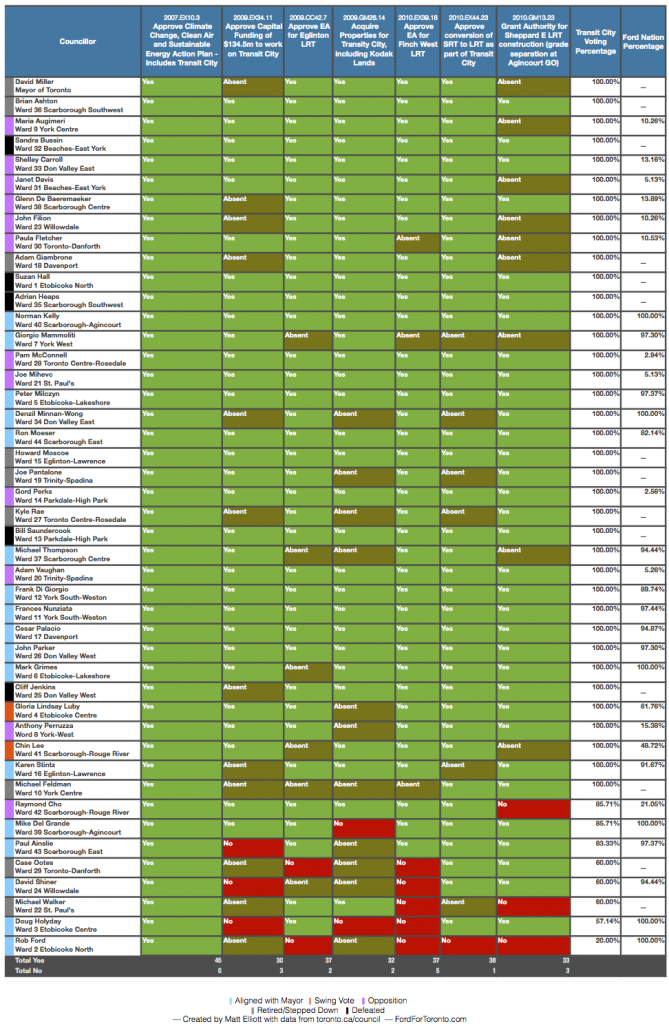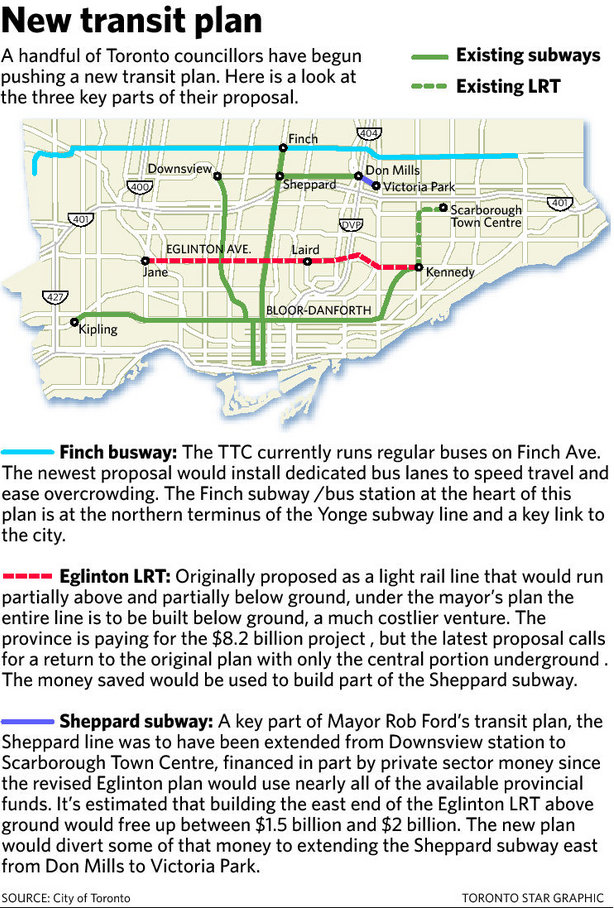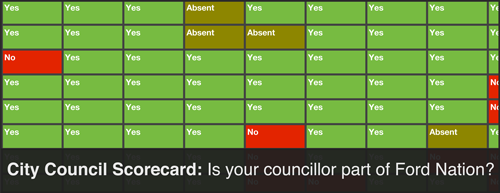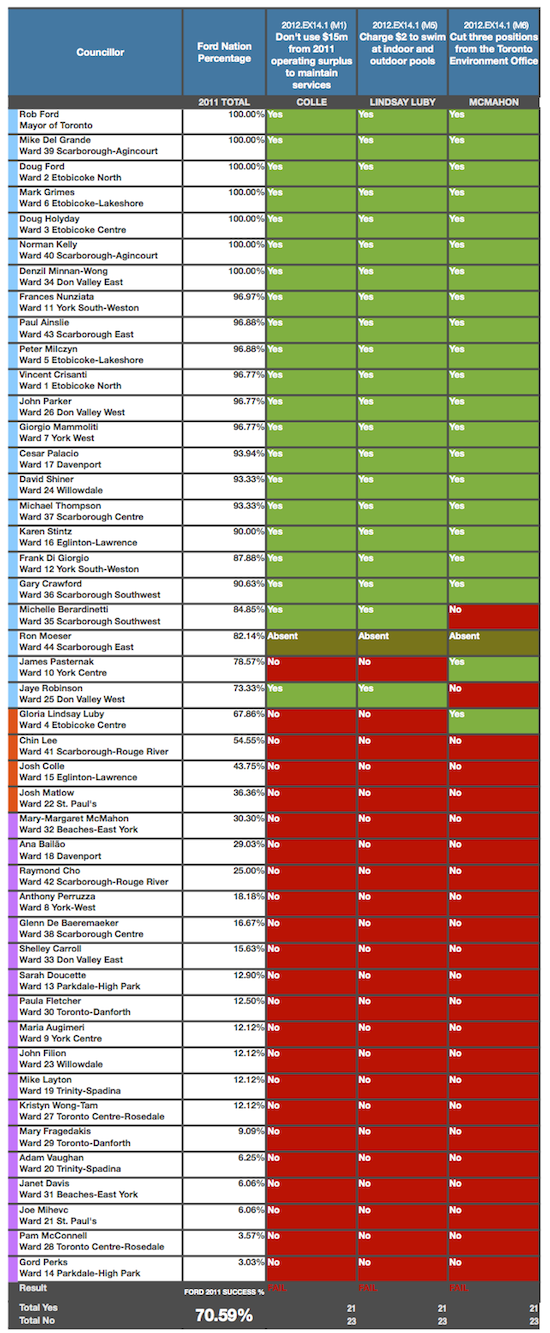
While there's no consensus view on overall transit planning amongst councillors, a strong majority are likely to vote in favour of bringing part of the Eglinton LRT back to the surface. Council could then work with Metrolinx and the TTC to develop and debate a plan to put the $1.5 to $2 billion in savings toward other projects like the Finch West LRT or the Sheppard Subway. The Transit City vote percentage is an indicator on how councillors voted on seven Transit City-related items.
Updated Feb 2 2012: Chart has been updated to reflect recent statements by Scarborough councillors.
So Metrolinx Chair Rob Prichard wrote a letter today:
We will soon have to choose between these competing proposals — namely at or below grade, east of Laird Drive to Kennedy Road. In order to continue with this important project we require the support, and clarity from, the City of Toronto. s such, we are concerned that the [Memorandum of Understanding] has not yet been confirmed by Toronto City Council. Our concern has been sharply elevated in recent days by widely reported public statements from TTC Chair Karen Stintz and other members of Council suggesting Council will reject the terms of the MoU and seek a different transit plan with Metrolinx.
Absent Council’s endorsement of the MoU, the City is not bound by the plan and it is increasingly difficult for Metrolinx to implement it. We believe that both you and Council must soon confirm the direction the City wishes to take.
via Robert Prichard’s Letter to Rob Ford and Karen Stintz.
Ontario Minister of Transportation & Infrastructure Bob Chiarelli followed this up with a comment on his Twitter account: “We’ve got to move forward with transit in Toronto. City needs to land on a single position.”
With these comments in mind, and knowing full well the money and infrastructure hanging in the balance, six councillors, all of them stalwart Ford allies, used their power as TTC commissioners yesterday to sideline TTC Chair Karen Stintz and destroy a staff recommendation that would have seen transit staff produce a report detailing “analysis of the [Eglinton LRT] scope, alignment and vehicle technology.”
That report almost surely would have raised a number of questions about the planned underground alignment for Eglinton east of the Don Valley Parkway. It very well could have triggered the debate at council we’ve been waiting for: the one where councillors will overrule the mayor and change his transit plan.
Rather than set those wheels in motion and have the debate that everyone agrees council needs to have, these councillors — Denzil Minnan-Wong, Norm Kelly, Frank Di Giorgio, Cesar Palacio, Vince Crisanti & TTC Vice Chair Peter Milczyn — opted to engage in weasely tactics designed to delay the process, even though delays could wind up costing the city significant amounts of money. Councillor John Parker called the decision “beyond comprehension.”
Stintz was fairly blunt in her reaction to this move, as reported by NOW’s Ben Spurr:
“There are so many fundamental issues that need to be addressed, not just for this commission but for the next fifty years of this city,†Stintz said. “The commission had a decision to get that information and debate it and consider it, or they could not get it. They chose not to receive it.â€
via Far more support for Stintz’s transit plan than Rob Ford’s | NOW Toronto.
Rob Ford knows he can’t win this vote, so his allies are trying to avoid the vote altogether.
Council Scorecard: How A Transit Vote Might Go
It’s important that any council debate on this subject remain limited in scope. The last thing we need is for 44 councillors to propose 44 different “transit visions” based on their own pet projects. Keep it simple: an up-and-down vote on whether we should acquiesce to Rob Ford and bury all of Eglinton or stick with the previously-approved Transit City alignment.
Once that decision is made, construction can move forward on Eglinton. Council can then work with Metrolinx and the TTC to set priorities and determine where to spend the remaining funds. (My preference would be for the Finch LRT to take priority, but the existence of federal money for Sheppard Avenue transit may complicate things.)
Provided council’s debate remains focused, I count 23 votes in favour of bringing Eglinton back to the surface. (The Toronto Star’s David Rider & Daniel Dale did most of the legwork on this one.) Those 23 votes are all council needs to pull off this off, though the vote will probably be more lopsided once the  nine undecided votes sort themselves out. I could see up to five of those fence-sitters going against the mayor.
While the result of the vote seems clear, the process for getting the item in front of council is still murky. Ford proved today that he’s got enough allies on the TTC commission to control the agenda there. To actually put this to vote, Council is going to have to get creative and find a way to bypass the committee/board process.
Unstoppable Force Meets The Immovable Mayor
Ford’s behaviour on this item isn’t surprising — his stubbornness was actually an asset on the campaign trail, even if it’s a terrible quality for a guy at City Hall — but it remains deeply irrational. In no way should this be a hill for the mayor to die on.
Stintz was sincere in her efforts to engineer this compromise as a way for Ford to save face and deliver some kind of Sheppard Subway extension. And there is no indication anywhere that the mayor’s popular support — which is only at 40% anyway — hinges on keeping the Eglinton LRT underground.
The smart move would be accepting a compromise and passing a unanimous motion at council affirming support for rapid transit on Eglinton Avenue. But Rob Ford doesn’t want to make the smart move. He doesn’t want to move at all.





